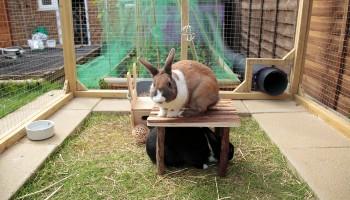Creating a rabbit-friendly hiding place
Providing hiding places in their home allows rabbits to escape and hide, helping them feel safe and reassured. You should give them hiding places in addition to their main shelter (such as their hutch, cage, shed).
Position hiding places in areas free from the sights and smells of potential predators, such as foxes, cats, dogs, ferrets, birds of prey and/or people. Place them away from draughts, out of direct sunlight and in a quiet area.
Hiding places should be high enough for rabbits to move underneath them quickly, but low enough to give them a feeling of security. If rabbits can jump onto them, they also function as platforms.
To ensure hiding places are effective and feel safe, never trap or remove rabbits from them.
If you keep more than one rabbit together
- Give them at least one hiding place per rabbit, preferably with an extra one, so that all your rabbits can hide at the same time
- Ensure hiding places have two entrances/exits, preventing dominant rabbits becoming territorial or aggressive to subordinates inside
- Provide at least one hiding place large enough for all rabbits to rest together
If you keep different sized rabbits together, make sure at least one hiding place has an entrance large enough for the smaller rabbit, but too small for the larger rabbit. This ensures smaller rabbits can escape from their larger companion.
If rabbits use hiding places regularly, hiding for lots of time, ask your vet for advice - they may be unwell, stressed or frightened. Your vet will rule out illness and injury that could be causing the behaviour problem and may then refer you to a qualified animal behaviourist.
For more information, read our guidance for using enrichment.



